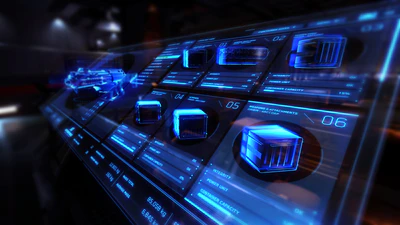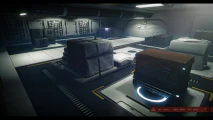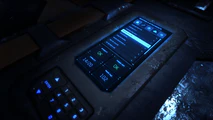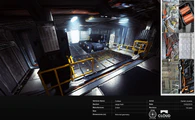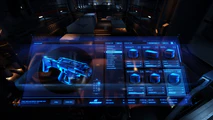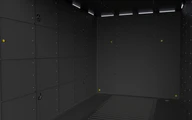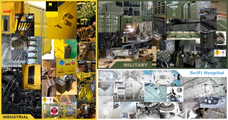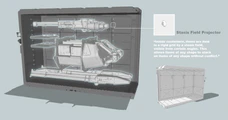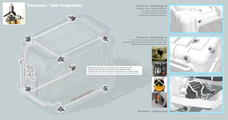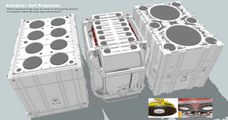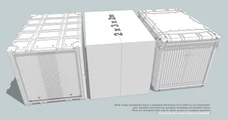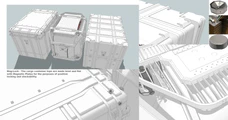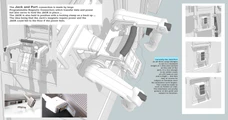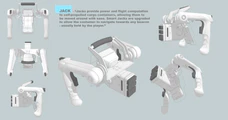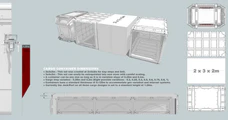Quick facts:Cargo
In Star Citizen, Cargo consists of bulk goods transported at a freight rate for commercial gain. Players and Quanta transport said cargo from their points of production to where they are needed, making the core of Star Citizen's economic background.
Ships and cargo
Most ships in Star Citizen can transport cargo, but in the majority of cases that cargo load is supposed to be composed of provisions, spare parts, supply, ammo, etc.
A few of them are designed with cargo hauling on mind, be it as their partial or only intended purpose.
Containers and cargo plates
A container is any receptacle or enclosure for holding a product used in storage, packaging, and transportation, including shipping. Things kept inside of a container are protected on several sides by being inside of its structure. The term is most frequently applied to devices made from materials that are durable and are often partly or completely rigid.
Every container has two key statistics: Standard Cargo Units (SCU) and Number of Ports. These define everything the game needs to know about loading a container onto a pallet or attaching it to a ship. SCU defines the exterior dimensions of the container in cubic meter increments, while the number of ports defines how many discrete slots into which items can be placed are available. Ports are 0.25m spaces.[1]
Besides this two key statistics, containers are defined by size and weight, health and shielding.[2]
Furthermore, the cargo transported inside a container can have different properties like hazardous, perishable, fragile, priority, etc.[2][3]
Some vehicles are limited in the size of the containers they can carry, from a max size of 1/8-SCU containers for the STV.[4] to a minimum size of 32-SCU containers for the RAFT, Hull C, Hull D and Hull E[5] Meanwhile, others like the Hull A and Hull B can carry a mix of container sizes.[6][7][8]
Cargo bay
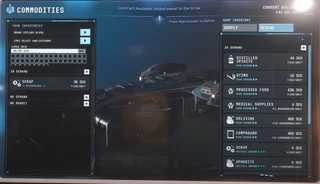
Star Citizen makes use of containers of different volumes or SCU values to store cargo. Containers fix themselves to the cargo plates. The SCU value introduced earlier defines the exterior dimensions of containers,[9] which is important to note because it allows the number of SCU a ship is rated for to actually correlate with the SCU value of all containers which can be placed inside that particular cargo bay. Containers are placed in a locking grid of sorts, which marks out (floor to ceiling) where cargo can be stored onboard a ship.
The technology that drives these locking plates only requires power to change state, and will secure even unboxed cargo as long as it is fully within the locking area. This means that only cargo containers can stack while disallowing infinite bridges, and that turning off the power plant won’t shred the ship with instant cargo shrapnel. Active locking plates are lit gold, although the light will change to red if there is something wrong: the cargo bay is too damaged to maintain lock, any of the items atop the plate cannot be secured and so on.[10]
As included in the final use case players must be able to interact with their cargo from the ship's onboard manifest. Using the manifest, you can activate and deactivate locking plates (to jettison cargo), set orders for arranging cargo and see the effect that all of your items are having on your center of mass.[1]
Off grid cargo
It should be noted that, although cargo can be stored outside the cargo plates area, it will not be secured and could shift causing damage all around and to the contained cargo.[1][9]
Goods that will be secured in place on the cargo grid will also be considered ‘declared’ on the ship’s cargo manifest. What this means is that when players go through customs checkpoints in the future, or are encountered by law enforcement out in the space lanes, their manifest will be broadcast like a trucker handing over a clipboard, declaring what’s inside their hold that everything is above board.[9]
This will allow a player to be able to make a conscious effort not to declare an item as well, by deliberately leaving it off the grid. As highlighted beforehand, a box left in a passageway risks unbalancing a ship, over-weighing it and rattling around in the back, but once the smuggling system comes online, players have a plus side in that it’s not broadcast to others as part of the manifest. A player who wants to slip a crate full of contraband through customs will be able to do so simply by leaving it off the grid and avoiding transmitting its details to a passing police officer.[9]
Of course, the police wouldn’t be doing their job properly if they just believed what every trucker told them, so they will be scanning ships on occasion to confirm what the transporter is ferrying, whether it is on the grid or not. To combat this, smugglers can add additional technology to their SCU crates such as ‘scramblers’ that will make it harder to detect illegal cargo, or ‘spoofers’, which make a container appear as something else altogether.[9]
Items and Commodities
In Star Citizen, cargo can be widely divided into Items and Commodities.
Items
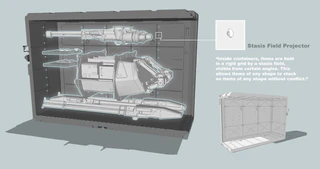
Items are also rated in the number of Ports they occupy when placed into a crate: a pistol is 1p, a rifle is 2p, a missile is 6p and so on. When an item is released inside the containment field of a crate, the item latches onto the nearest port and animates into place.[1]
Commodities
Commodities are the goods that can be regarded as fit for use as cargo, where not falling under another category such as Personal Weapons or Props. They are used in 'recipes' by the Dynamic Economy system.
Trade

Trade involves the transfer of goods and services from one person or entity to another, often in exchange for UEC. In Star Citizen trade is done by both players and quantas.
Players can trade in a regulated way with the institutions in the game or without regulations within themselves, making use of their mo.Trader app in their mobiGlass.
In regards to cargo trading, it is intended that players in Star Citizen can practice commodity trading and cargo hauling in bulk.[10][11]
Commodity trading
As of version Alpha Patch 3.17.4 commodity trading is the only way to trade with cargo in bulk.
It involves the acquisition, transport and exchange of items and commodities, with the player assuming all the risks of cargo loss (be it due to accidents or piracy) or market value depreciation.
Cargo hauling
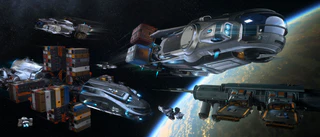
Cargo hauling is a service provided by a player or a quanta, where the cargo is not owned by the pilot. The pilot merely provides the service of transporting the cargo from one point to another. The vehicle employed doesn’t need to be necessarily owned by the player, as it can be rented, loaned by another player or belong to the institution requesting the service.[11]
As of version Alpha Patch 3.17.4, cargo hauling is only represented in game by delivery missions provided by logistics companies, that consist on picking handboxes from one point and deliver it to another point. After manual loading is implemented, this will include cargo hauling in bulk.[10]
Cargo deck

Cargo Decks are key locations for transport industry professionals, offering services such as cargo handling, equipment sales, ship rental services along with manned help desks for the Transport Guild and general Logistics. Cargo decks can currently be found at stations in geosynchronous orbit around major planetary hubs.[12]
Cargo stowage

As cargo is physicalized in Star Citizen, it needs to be stowed in and out of the vehicles carrying it. As of version Alpha Patch 3.17.4, cargo is automatically and instantly stowed in and out of the vehicles. Eventually, when manual stowage is implemented, stowage could be done by players or by game mechanics.[13] This will take cost and time.[10]
Vehicle destruction and piracy

In the event of a vehicle carrying cargo being destroyed, there is a 70% chance that the vehicle is not completely destroyed, but wrecked in what is called a ‘’soft death’’. In this scenario the whole cargo will survive and can be picked by anyone willing to do so. In the remaining 30 % chances, the ship will explode and 0-90 % of the cargo will be expelled from the hull, again ready to be picked by anyone willing to do so.[10]
The goods still belong to the rightful owner and anyone else wanting to benefit from their acquisition will have to employ a "No Questions Asked" terminal and they will not receive full price for anything that they are trying to sell.[10]
Cargo insurance
As of version Alpha Patch 3.17.4, cargo can not be insured; but it is intended that this becomes possible.[1][11]
Scanning
The scanning feature allows the player to scan vehicles in more detail, and over a number of seconds it will gather information about what cargo they're carrying. This of course depends on how good your scanning hardware is and how good the blocking hardware of what you're trying to scan has.[14][15]
Gallery
See also
References
- ↑ Jump up to: 1.0 1.1 1.2 1.3 1.4 Comm-Link:Cargo Interaction. Engineering - Comm-Link
- ↑ Jump up to: 2.0 2.1 CitizenCon 2953: Destination Adventure. Retrieved 2024-02-06 on YouTube
- ↑ Inside Star Citizen: Design Brief: Cargo Career, Part I. Retrieved 2024-02-06 on YouTube
- ↑ Greyat STV. Transmission - Comm-Link. Retrieved 2022-10-08
- ↑ Q&A Argo RAFT. Engineering - Comm-Link. Retrieved 2021-11-25
- ↑ Q&A: MISC Hull A. Engineering - Comm-Link
- ↑ Hull A with cargo loaded. Adam Parker: «Yes, the individual boxes are planned to be able to be replaced with 16 SCU containers, that is part of the cargo refactor iirc. instead of using the smallest crates, the system will figure out the largest crates that can be put on a cargo grid and use those, then use smaller and smaller crates until the grid is fully filled up.»
- ↑ "Behind the Scenes: Making the MISC Hull A". Jump Point. Vol. 10 no. 4. pp.12. Retrieved 2022-12-12.
- ↑ Jump up to: 9.0 9.1 9.2 9.3 9.4 The Shipyard:SCU and Cargo Capacity - A Guide to the New Ship Matrix. Engineering - Comm-Link
- ↑ Jump up to: 10.0 10.1 10.2 10.3 10.4 10.5 Cargo Refactor AMA Recap. Transmission - Comm-Link
- ↑ Jump up to: 11.0 11.1 11.2 Q&A: Hull E. Transmission - Comm-Link
- ↑ ISC - Cargo Embargo No Largo. Transmission - Comm-Link. Retrieved 2021-03-27
- ↑ Inside Star Citizen: Hull of a Show. Retrieved 2022-12-12 on YouTube
- ↑ Monthly Report: August 2015. Transmission - Comm-Link
- ↑ Monthly Report: February 2016. Transmission - Comm-Link
